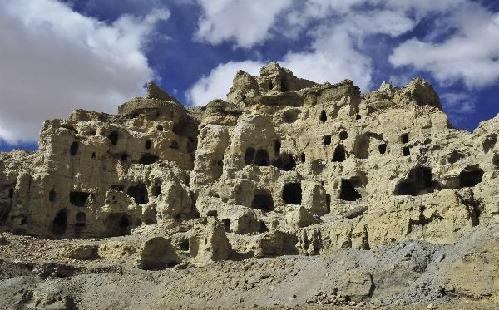
The grottoes, divided into two clusters of 200 and 1,000 caves, respectively, hold remains of ancient monasteries, fortresses, and forests dating back as far as the 10th century. Experts expect that the well-preserved grottoes will shed some light on the Guge Kingdom, an ancient kingdom that is estimated to have existed between the 9th and 17th centuries in what is known today as Zanda County.

The exotic frescoes of the Donggar Piyang grottoes were first discovered in 1992, when an archaeological expedition team set foot in this remote corner of the Qinghai-Tibet Plateau, according to Li Xingguo, director of the cultural bureau of the Ngari Prefecture. It was listed as a protected cultural relic site in 1997 and immediately underwent a two-year restoration, Li said.

Lao Yu, the head of an off-road vehicle club based in the Tibetan city of Lhasa, said that the grottoes have been well-preserved because of their geographical remoteness and the "camouflage effect" of the sandstone hills "The grottoes are not far from the town proper, but were not discovered until 1992," said Lao Yu, one of the grottoes' few frequent visitors. "However, as modern roads continue to be built in this region, more visitors are expected to come," Lao Yu said.

Buddhism has been the dominant religion in Tibet for centuries. Monks seeking an ascetic way of life took shelter in the caves and turned them into places of worship, complete with frescoes depicting the life of Buddha.

Buddhist murals have been previously found in north China's Shanxi Province and in the desert city of Dunhuang in northwest China's Gansu Province. Experts say the discovery of the Donggar Piyang grottoes provides a missing link for historians, allowing them to fully trace the origins of Buddhism in China.

Frescoes that are currently open to the public mainly depict Buddhas, Bodhisattvas and other deities, but also feature animals that are not native to Ngari. "The frescoes have a twist of Kashmir flavor. They are a valuable resource for archaeologists who are trying to figure out when and where Buddhism was introduced to China," said Lao Yu.

Despite their long history, the thousand-year-old frescoes have managed to maintain their vivid coloring. Dawazhoima, head of the cultural bureau of Zanda County, said that the frescoes have held up well because of the way they were produced.

Monks employed powdered minerals to create the bright watercolor paints that they used to make the frescoes, Dawazhoima said. "The frescoes are composed of smooth lines, with bright colors and unique designs. It is rare to see frescoes of such high craftsmanship," she said. Dawazhoima also stated that the local government has requested state funding for the purpose of preserving the frescoes.

Yang Nianhua, a Ngari literary writer, said that according to researchers, the grottoes may have been part of the ancient Guge Kingdom, whose rulers fostered the spread of Buddhism. Studies show that art flourished during the Guge Kingdom, particularly during the 10th century. This resulted in the production of a vast quantity of unique artwork, from paintings to architecture. The Guge Kingdom was founded around the 9th century by a descendant of King Lang Darma, who fled from Lhasa after the collapse of the Tubo Kingdom, according to historical records.

Remains of the kingdom's main castle now lie atop a riverside mountain, covering 180,000 square meters. Archaeologists said that the 3-story ruins include palace halls, temples and hundreds of other rooms. Li said that archaeologists suspect that wars brought an end to the Guge Kingdom, as remnants of shields, armor and arrows have been found in the ruins. "When war breaks out, the end is predictable," he said.
Source: Xinhua - People's Daily Online [June 12, 2011]